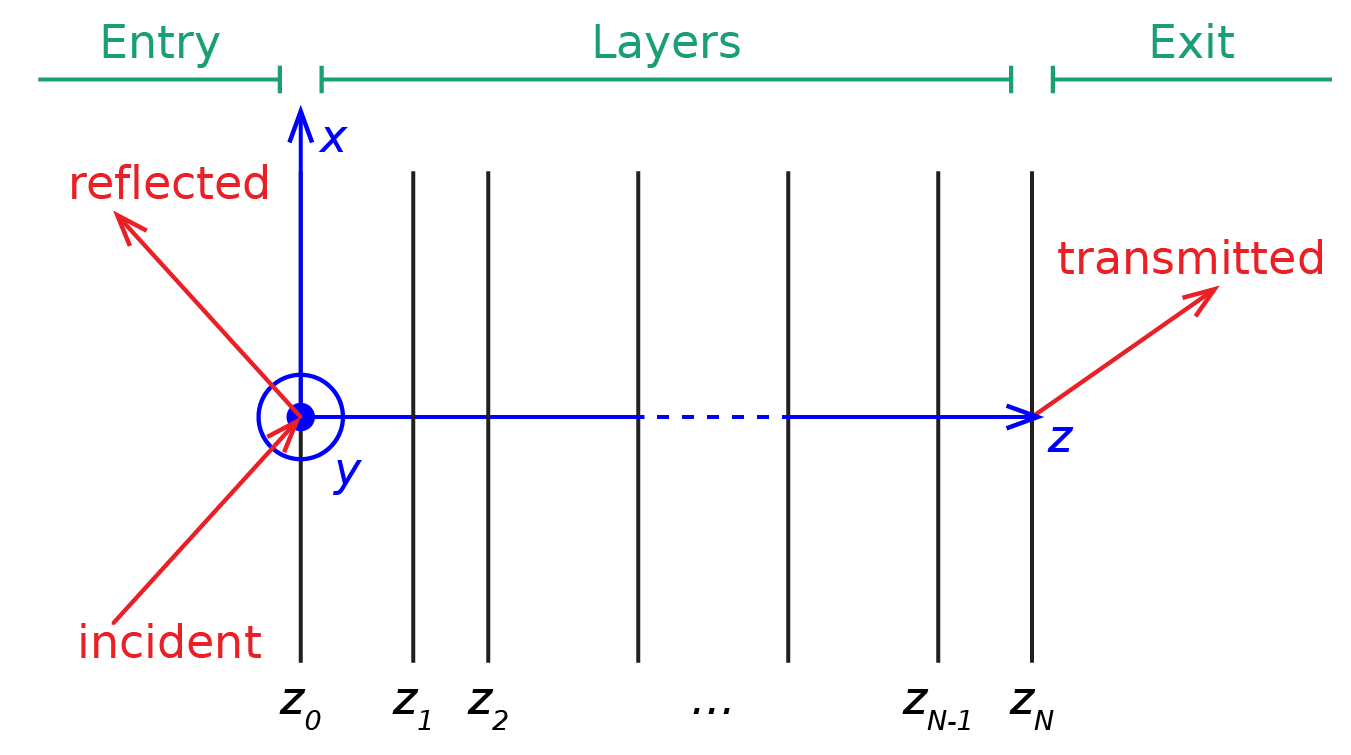Getting started¶
Overview¶
PyLlama enables to calculate the reflection and transmission spectra of an arbitrary multilayer stack whose layers are made of dispersive or non-dispersive, absorbing or non absorbing, isotropic or anisotropic materials. The layers are assumed to be perpendicular to the  axis and homogeneous and infinite in the
axis and homogeneous and infinite in the  and
and  directions. The stack is sandwiched between an entry and an exit semi-infinite isotropic media, such as air.
directions. The stack is sandwiched between an entry and an exit semi-infinite isotropic media, such as air.

Fig. 1 Schematic of the axes and the multilayer stack between entry and exit semi-infinite media.
We use two different matrix method approaches to calculate the reflectance and transmittance of a multilayer stack: the transfer matrix method and the scattering method. Both methods are based on the same optical principles: continuity of the electric and magnetic fields at the interfaces between the layers (referred to as “transition”) and phase build-up inside the layers (referred to as “propagation”). We describe the underlying theory in our paper that the user of the code is invited to read.
Code organisation¶
PyLlama is a code that can be used as a package (the user imports the code and uses the implemented classes and methods) and can be customised (the user writes their own routines to model specific multilayer stacks in form of children classes).
The code in pyllama.py is organised as follows:
- the three classes
Wave,Layer(and its childHalfSpace) andStructureimplement the optical calculations described in our paper. In principle, the user should not modify these classes. - the class
Modeland its children contain routines that constructStructureinstances through useful routines. The user should use these classes in scripts (some scripts are available on StackMat’s GitHub repository) and may also add their own children classes to the code. - the class
Spectrumprovides an extra level of automation to calculate full spectra in one command and to export results in Python-compatible (Pickles) or MATLAB format. The user should use this class in scripts and may also interface it with their custom child classes ofModel.
How to install¶
PyLlama requires Python 3 to run. It has been tested with Python 3.6 from Python 3.8. It also requires the following packages (other versions may work too):
- Numpy version 1.18 to 1.19
- Sympy version 1.4 to 1.6
- Scypy version 1.2 to 1.5
- Matplotlib version 3.2
The file pyllama.py must be downloaded and placed in a location that is in Python’s path. It contains the classes and function required to build multilayer stacks and calculate their reflectance. In each script, PyLlama must be imported with:
import pyllama
Custom libraries may be used in interaction with the class Model to construct Structures. The user should ensure that they have installed all the required libraries.
Library for cholesterics¶
The file cholesteric.py is required to work with the class CholestericModel, and the file geometry.py contains tools to represent cholesterics in 3D plots. If the used wishes to use the class CholestericModel, they need to import the Cholesteric class with:
import cholesteric
If the user does not wish to use the class CholestericModel, they do not need to download cholesteric.py nor geometry.py.